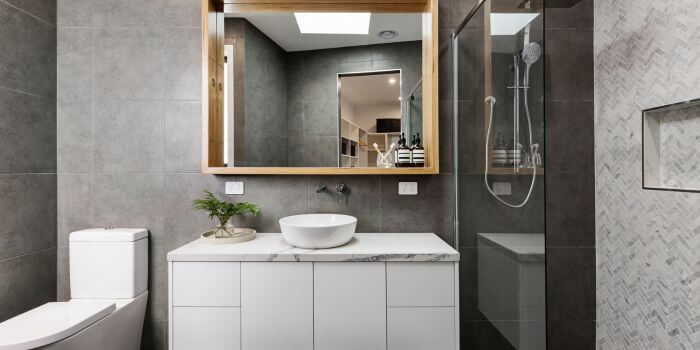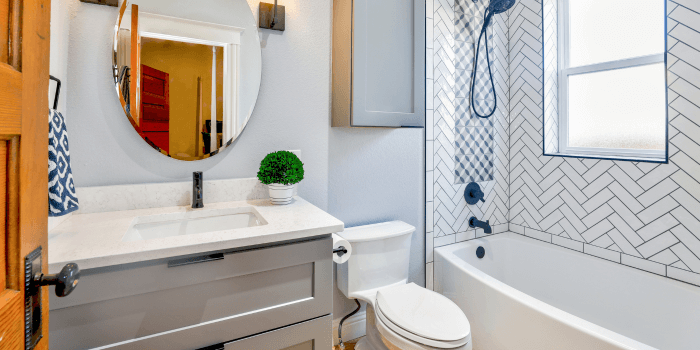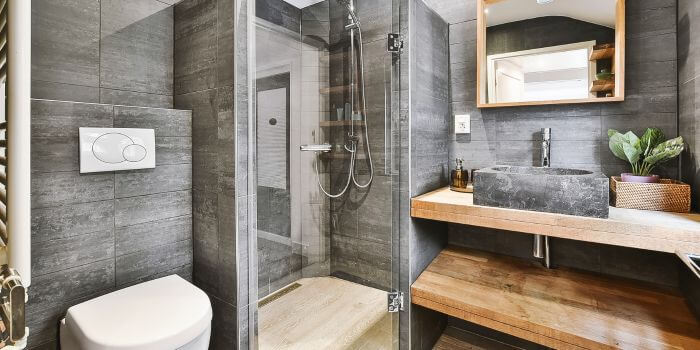Table of Contents
Bathroom Renovation
Renovating a bathroom on a budget can be challenging, but it’s definitely possible with some strategic planning and creativity. Here are some tips to help you renovate your bathroom without breaking the bank:
Set a budget:
To find out how much you can comfortably put toward your bathroom makeover project, take a close look at your finances.
Make a contingency fund to cover any unforeseen costs that may arise.
To get a realistic notion of what your budget should be, find out what the average costs of labor and materials are in your area.
Plan ahead
Measure your bathroom space accurately and create a detailed floor plan to visualize the changes you want to make.
Consider factors such as plumbing and electrical requirements when planning the layout to avoid costly adjustments later on.
Create a mood board or gather inspiration from magazines and online resources to help you define your desired aesthetic and style.

DIY whenever possible
Assess your skills and comfort level with various tasks, such as painting, installing fixtures, laying tile, and basic carpentry.
Take advantage of online tutorials, DIY books, and community workshops to learn new skills and techniques.
Invest in quality tools and safety equipment to ensure efficient and safe completion of DIY projects.
Shop around for materials
Visit local home improvement stores, clearance centers, and online retailers to compare prices and find the best deals on materials.
Look for discontinued or overstocked items that may be available at discounted prices.
Consider purchasing gently used or salvaged materials from architectural salvage yards or online marketplaces for cheap baths that can really save money while adding character to your bathroom.
Consider alternatives:
Explore budget-friendly alternatives to expensive materials, such as laminate countertops instead of granite or quartz, luxury vinyl plank flooring instead of hardwood, and porcelain tile instead of natural stone.
Refinish or resurface existing fixtures, such as bathtubs, sinks, and countertops, instead of replacing them to save money and reduce waste.
Get creative with repurposing items from other areas of your home or repurposing thrifted finds to add unique touches to your bathroom design.
Focus on high-impact changes
Identify key areas of your bathroom that will have the most significant impact on the overall look and feel, such as updating outdated lighting fixtures, replacing worn-out flooring, and refreshing the paint color on the walls.
Prioritize investments in durable, high-quality materials and fixtures for areas that receive heavy use, such as showers, countertops, and flooring.
Reuse and repurpose
Assess the condition of existing fixtures and materials in your bathroom to determine if they can be salvaged, refinished, or repurposed.
Consider giving old cabinets a fresh coat of paint or refinishing them to match your new design aesthetic.
Explore creative ways to repurpose items from other rooms, such as turning an old dresser into a vanity or repurposing vintage mirrors as decorative accents.

Don’t overlook small upgrades
Pay attention to details like updating old faucets and showerheads with more modern, water-efficient models, replacing outdated cabinet hardware with stylish alternatives, and adding decorative touches like new towel bars and robe hooks.
Consider upgrading outdated light fixtures with energy-efficient LED options to improve both the aesthetics and functionality of your bathroom.
Do the work in stages
Break down your renovation project into manageable phases and prioritize tasks based on your budget and timeline.
Start with essential upgrades, such as addressing any structural or safety issues, before moving on to cosmetic improvements.
Be flexible and willing to adjust your plans as needed to accommodate changes in your budget or unexpected complications that may arise during the renovation process.
Seek professional advice when needed
Consult with experienced professionals, such as plumbers, electricians, and contractors, to assess the feasibility of your renovation plans and obtain expert advice on technical aspects of the project.
Consider hiring licensed professionals for tasks that require specialized skills or knowledge, such as plumbing and electrical work, to ensure compliance with building codes and safety standards.
Obtain multiple quotes from reputable contractors and tradespeople to compare costs and ensure you’re getting a fair price for the services you need.
Common Mistakes When Renovating a Bathroom
Renovating a bathroom can be a daunting task, and there are several common traps that people can fall into during the process.
Being aware of these pitfalls can help you avoid them and ensure a smoother renovation experience. Here are some traps people often encounter when renovating their bathrooms:
Underestimating the Budget
One of the most common traps is underestimating the cost of the renovation. People may fail to account for unexpected expenses, such as plumbing issues or structural repairs, which can quickly inflate the budget.
To avoid this trap, it’s essential to thoroughly research the costs of materials and labor, add a contingency fund to your budget, and prioritize your spending on essential items.
Ignoring Plumbing and Electrical Considerations
Renovating a bathroom often involves plumbing and electrical work, which requires careful planning and consideration.
Ignoring or overlooking plumbing and electrical considerations can lead to costly mistakes and safety hazards down the line.
It’s crucial to consult with professionals, obtain necessary permits, and ensure that all plumbing and electrical work complies with building codes and regulations.
Focusing Solely on Aesthetics
While aesthetics are essential in a bathroom renovation, focusing solely on appearance can overlook functional aspects that are equally important.
Forgetting to prioritize functionality and practicality can result in a beautiful but impractical bathroom that doesn’t meet your needs.
It’s essential to strike a balance between aesthetics and functionality by considering factors such as layout, storage, and accessibility.

Skipping Proper Planning and Preparation
Rushing into a renovation without proper planning and preparation can lead to delays, mistakes, and dissatisfaction with the final result.
Skipping steps such as measuring the space, creating a detailed floor plan, and obtaining necessary permits can result in costly errors and setbacks.
Taking the time to plan and prepare adequately before starting the renovation can help ensure a smoother and more successful outcome.
Overlooking Ventilation and Moisture Control
Proper ventilation and moisture control are essential in a bathroom to prevent mold, mildew, and moisture-related damage.
Overlooking ventilation requirements or installing inadequate ventilation can lead to issues such as mold growth, peeling paint, and wood rot.
It’s important to install a properly sized exhaust fan, ensure adequate airflow, and use moisture-resistant materials to mitigate moisture problems effectively.
Ignoring Building Codes and Regulations
Ignoring or disregarding building codes and regulations can lead to serious consequences, including fines, project delays, and safety hazards.
It’s crucial to familiarize yourself with local building codes and regulations, obtain necessary permits, and ensure that your renovation complies with all applicable laws and standards.
Also, Read
5 Styling Secrets to Make Your Home Look Amazing
What Are the Common Signs That My AC Needs Repair?
5 Reasons You Need to Upgrade Your Home Electrical System
Smart Homes, Smart Design: Integrating Technology Seamlessly